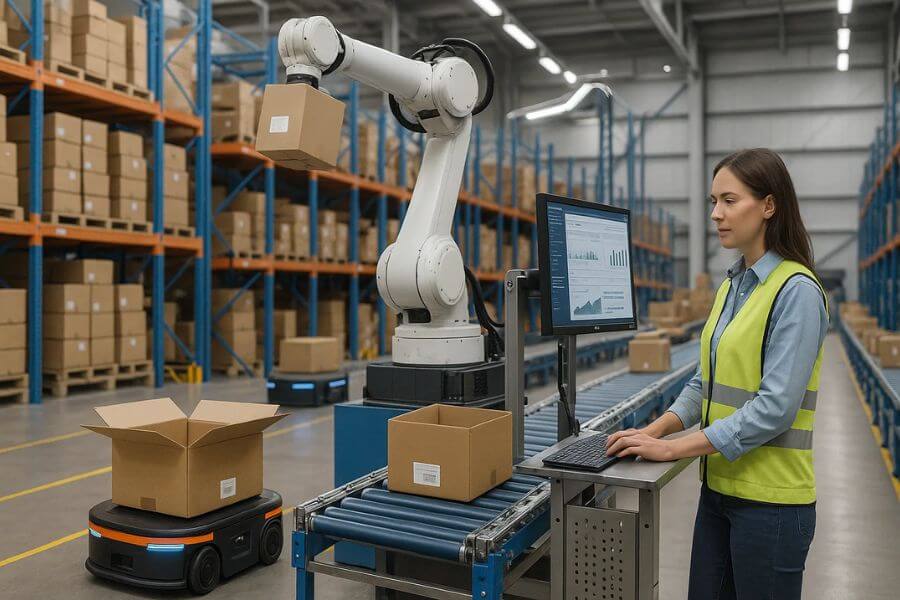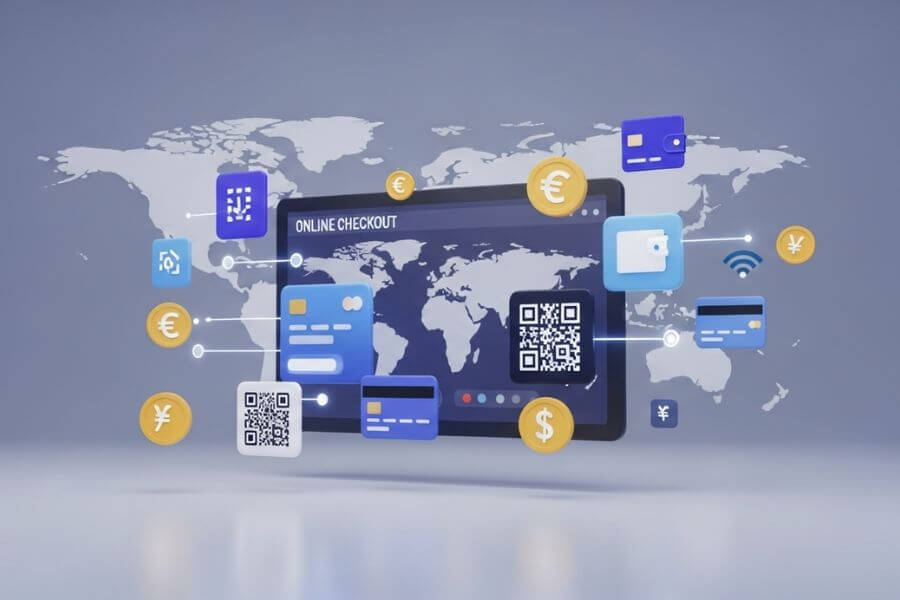Ecommerce has become an essential part of daily life, and its growth is projected to continue at an unprecedented pace in 2025. For many customers, online shopping seems simple: browse, click “buy,” and wait for delivery. However, the reality of ecommerce fulfillment is far more complex than most realize. Behind every seamless transaction is a sophisticated ecosystem of technology, logistics, and strategic planning.
In this article, we’ll explore 10 things customers don’t realize about ecommerce fulfillment in 2025, giving a closer look at what happens behind the scenes to make fast, accurate, and convenient delivery possible.
1. Ecommerce fulfillment is a high-tech operation
Ecommerce fulfillment in 2025 is far from the manual, labor-intensive warehouses of the past. Today, fulfillment centers are highly automated hubs, leveraging AI, robotics, conveyor systems, and advanced warehouse management software (WMS) to streamline operations. Robots now assist in tasks such as picking products from shelves, scanning barcodes, sorting items, and even packing them into customized boxes. Human workers focus on oversight, exception handling, and quality assurance.
Moreover, predictive analytics and AI algorithms anticipate demand, identify stock shortages, and adjust workflows to maintain high efficiency. For instance, a popular gadget trending on social media can trigger AI to reprioritize warehouse operations, ensuring sufficient stock is picked and shipped before a spike in orders.
Why it matters for customers: When you receive an order within hours of purchase, it’s not luck; it’s the result of advanced technology orchestrating countless processes simultaneously.
2. Shipping speed comes at a cost
Many customers assume shipping is simple and inexpensive, but in reality, fast shipping is a costly operation. Next-day and same-day delivery require highly coordinated logistics, including premium carrier partnerships, strategically located fulfillment centers, and optimized transportation routes.
In 2025, urban areas benefit from microfulfillment centers, which are small warehouses located near dense population centers. These centers reduce shipping distances and enable lightning-fast delivery, sometimes within hours. However, establishing and maintaining such infrastructure comes at a premium cost, often absorbed by businesses to remain competitive.
Additionally, shipping speed isn’t just about distance. Seasonal fluctuations, weather events, and last-mile logistics challenges can increase costs and require contingency planning. This is why “free shipping” often involves hidden costs built into product pricing.
Customer takeaway: That two-day or next-day shipping isn’t magic; it’s an expensive, highly coordinated effort.
3. Real-time inventory management is critical
When customers see a product listed as “in stock,” they rarely realize how dynamic inventory management is. Ecommerce companies in 2025 rely on real-time inventory systems to track stock across multiple warehouses, retail stores, and online marketplaces simultaneously.
These systems are connected to AI-driven algorithms that predict demand patterns based on historical sales, seasonal trends, and external factors like viral trends or social media campaigns. For example, if a summer fashion item suddenly becomes popular on TikTok, AI can automatically allocate stock from multiple warehouses to areas with the highest anticipated demand.
Real-time inventory tracking also helps prevent overselling, reduces backorders, and improves customer satisfaction by ensuring accurate stock information.
Customer insight: The “in stock” label is the tip of a complex inventory management iceberg.
4. Returns are a major challenge
Returns are one of the most overlooked aspects of ecommerce fulfillment. Customers often assume returning an item is simple, but reverse logistics is a complex, costly process. Returned items must be transported back to warehouses, inspected for damage, restocked, or disposed of, depending on condition.
In 2025, ecommerce companies leverage AI and data analytics to optimize the returns process. Predictive models identify products with high return likelihood, allowing companies to improve descriptions, sizing guides, or packaging to minimize returns. Advanced reverse logistics networks ensure returned items are efficiently sorted and processed, reducing turnaround time and costs.
For customers, the ease of returns is largely invisible. Each return requires careful planning and significant resources, from labor to transportation and warehousing.
Customer takeaway: Hassle-free returns don’t happen by accident; they are the result of sophisticated logistics and planning.
5. Packaging is more than just a box
Most customers don’t realize how much thought goes into ecommerce packaging. In 2025, packaging is designed not only for protection but also for sustainability, branding, and customer experience.
Advanced packing systems in fulfillment centers automatically adjust box sizes to minimize wasted space, add protective padding, and even personalize packaging with branded inserts or messages. Many companies now use eco-friendly materials, including biodegradable fillers, recyclable boxes, and plant-based plastics, to meet growing consumer demand for sustainability.
Proper packaging ensures products arrive safely, reduces shipping costs by minimizing dimensional weight charges, and enhances the unboxing experience, something customers often take for granted.
Customer insight: Every carefully packed box represents a combination of logistics strategy, cost management, and brand experience.
6. Last-mile delivery is the hardest part
The “last mile,” the final step from the warehouse to the customer’s doorstep, is the most challenging and expensive part of ecommerce fulfillment. In urban areas, traffic congestion, parking limitations, and time-sensitive deliveries complicate the process. In rural areas, accessibility and longer distances increase cost and complexity.
In 2025, ecommerce companies use advanced route optimization software, drones, autonomous delivery vehicles, and microfulfillment centers to make last-mile delivery more efficient. Real-time tracking and predictive delivery windows also enhance the customer experience. For example, some companies can predict the exact 30-minute window a package will arrive based on traffic and weather data.
Customer takeaway: That smooth delivery to your door is the result of meticulous planning and cutting-edge technology.
7. Fulfillment centers are strategically located
Customers rarely realize that products don’t come from a single warehouse. Ecommerce companies strategically locate fulfillment centers near high-demand areas to reduce shipping time and cost. Some brands also use distributed inventory models, keeping stock in multiple regional centers to serve customers faster.
In 2025, AI-driven predictive demand models help businesses allocate inventory dynamically. For instance, a surge in demand for a specific product in the Midwest could trigger automatic reallocation of stock from other regions, ensuring fast delivery without overstocking.
Customer insight: When an order arrives quickly, it’s often because warehouses and inventory have been strategically positioned to reduce shipping time and optimize cost.
8. Customer data drives fulfillment decisions
Every action a customer takes: browsing, purchasing, or abandoning a cart, feeds into fulfillment strategies. Ecommerce fulfillment in 2025 is highly data-driven. Customer behavior is analyzed to forecast demand, optimize inventory, personalize packaging, and even determine delivery methods.
For example, repeat customers may receive products packed in a preferred way or shipped via their preferred carrier. AI can also detect trends, such as products with higher likelihood of returns, and adjust fulfillment strategies to minimize costs.
Customer takeaway: Behind every seamless order is a wealth of customer data informing decisions that improve accuracy, speed, and satisfaction.
9. Sustainability is shaping fulfillment practices
Sustainability is no longer optional; customers in 2025 expect it. Fulfillment centers are integrating green practices, such as route optimization, energy-efficient warehouse lighting, solar panels, and electric delivery vehicles. Packaging innovations reduce waste, while AI predicts demand to minimize overproduction and unnecessary shipments.
Some companies are even implementing circular logistics models, repurposing returned or excess products to reduce landfill impact. Sustainable fulfillment is now both a competitive advantage and a customer expectation.
Customer takeaway: When you receive a fast, eco-friendly delivery, it represents careful planning to balance speed, cost, and environmental impact.
10. Fulfillment is a competitive advantage
Finally, ecommerce fulfillment is more than just logistics; it’s a strategic differentiator. Speed, accuracy, packaging quality, and returns management directly influence customer loyalty and brand perception.
In 2025, companies investing in advanced fulfillment operations gain a significant edge. Brands that offer fast shipping, seamless returns, and eco-friendly practices consistently outperform competitors who neglect these areas. Fulfillment has become a key factor in customer satisfaction and retention, shaping the overall ecommerce experience.
Customer insight: A smooth, reliable order delivery reflects not only convenience but also sophisticated logistics, technology investment, and strategic planning.
Conclusion
Ecommerce fulfillment in 2025 is a complex, technology-driven, and customer-centric operation. From AI-powered warehouses and real-time inventory management to last-mile delivery optimization and sustainable packaging, the system behind every order is intricate and highly coordinated.
Customers rarely see these operations, but they directly impact speed, accuracy, convenience, and sustainability. Understanding the complexity behind ecommerce fulfillment allows shoppers to appreciate the effort and technology that make online shopping seamless in 2025.





